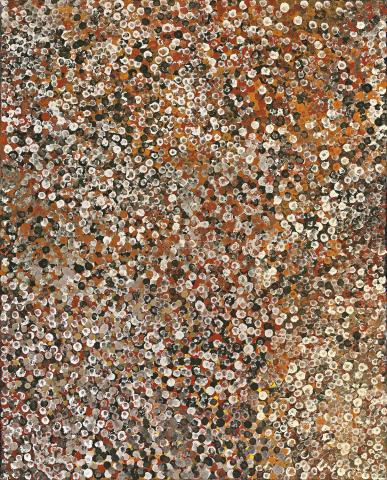TRANSITION, 1990
EMILY KAME KNGWARREYE
synthetic polymer paint on linen
150.0 x 120.0 cm
bears inscription verso: artist’s name and Delmore Gallery 0Q90
Delmore Gallery, via Alice Springs
Chapman Gallery, Canberra
Allan Boxer, Canberra, acquired from the above in 1991
Private collection, Melbourne
Crossing Cultures: Art from the Boxer Collection, Drill Hall Gallery, Australian National University, Canberra, 4 May – 18 June 2000, cat 20 (as ‘Of a Rare Winter Rain’)
The First Flowers of Summer, 1990, synthetic polymer paint on canvas, 210.0 x 122.0 cm, formerly in the Holt collection, Alice Springs, illus. in Isaacs, J., Smith, T., Ryan, J., Holt, D., and Holt, J., Emily Kame Kngwarreye Paintings, Craftsman House, Sydney, 1998, pl. 14, p. 60
This painting is accompanied by a certificate of authenticity from Delmore Gallery.
Emily Kame Kngwarreye holds a position in history as one of Australia’s most significant contemporary artists and it is difficult to think of another who, having started painting so late in life, left such an enduring mark on modern Australian art. She was a prolific artist who often worked at a pace that belied her advanced age. It is estimated that she produced over 3000 paintings in the course of her eight-year career — an average of one painting per day. For virtually two-thirds of her life she had only sporadic contact with the outside world. It was not until she was almost 80 that she became, almost overnight, an artist of national and international standing.
Painted during a build up before a storm and completed as the rain was very imminent, Transition, 1990 was included in the exhibition Crossing Cultures: Art from the Boxer Collection, held at the Australian National University Drill Hall Gallery in Canberra in 2000. This painting is prescient of her later 1992 paintings in which Emily swapped her small brush and technique of overlaid clouds of dots, for a larger brush that produced floret shaped marks. By using a larger brush and ‘double dipping’, she produced florets of colour by bringing the brush down vertically on the canvas, then lifting it off with a twist.1 This work however belongs very much in that early period with the marks spreading right to the edges of the whole canvas and the restricted palette also very characteristic of Emily’s early tonal works. Painted over a dark grey ground and overlaid with sequences of florets of red, yellow and orange built up through rhythmic application, and topped further with florets of white, grey and black – suggesting the first splashes of rain on the parched desert - this painting anticipates the post rain transition from barren to lush and fertile.
The painting of Emily Kame Kngwarreye is often seen as a link between the old and the new / indigenous and non-indigenous and her works have been viewed in parallel with modern, twentieth century abstraction. Her art, however, is founded on decades of mark-making for private purposes, of drawing in the soft earth or painting on the bodies of women for ceremony, reflecting her participation in a lifetime of traditional cultural practice. Emily’s true achievement is her inventive and original contribution to Aboriginal art.
1. Isaacs, J., ‘Kame flowers’, Emily Kngwarreye Paintings, Craftsman House, Sydney, 1998, p. 21
CRISPIN GUTTERIDGE
